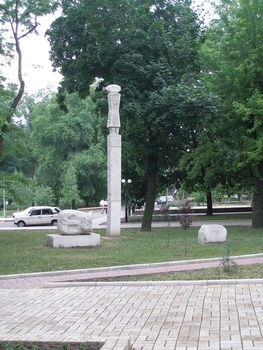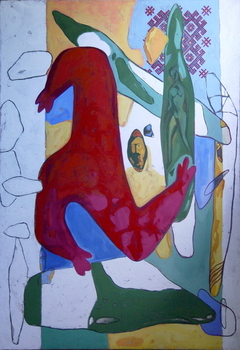The clique that now wields power in Ukraine has, through its example, firmly established a negative stereotype of people from Donetsk. However, not all of them need be “thanked” for the president that we have. There are those that deserve our sincere gratitude in other fields. A great example is Petro Antyp, a European-calibre sculptor who has stayed in his native city of Horlivka. One of the most revealing facts of his biography is that even though he was born in 1959, he never joined the Komsomol. Antyp, whose workshop spans four hectares, gave an interview to The Ukrainian Week.
U.W.: You were a member of the Helsinki Union in Donetsk Region. What where its activities?
In 1989, I met Levko Lukianenko and joined the Helsinki Union. There were 5-10 members in the Donbas, and our activity was standard: organizing meetings, discussing the prospects of independence, singing songs and distributing leaflets. I am bound to Ukraine on the genetic level, so I first joined the Helsinki Union and then the Republican Party. I was a member of the human chain that stretched from Kyiv to Lviv.
From the distance of all these years there is only one thing that amazes me — no-one spoke about money back then. Some 300 people, enthusiasts, would come to meetings of Rukh. There was a simple need to create an independent Ukraine. Later, people went to different parties. And now that parties pay people to participate in rallies, it has all turned into business.
U.W.: You are still politically active. Why? Can a true artist also engage in politics?
History has many examples of artists who became engaged in politics. It is almost unreal to live in isolation from it. We can think, for example, about Rubens, who was a diplomat, or Goya and Velasquez who were members of the royal court. It is fiction that painters are free of politics. If an artist is good enough, he will automatically be involved in politics, because his words carry weight. Frankly, I would never do politics if I had been born in Poland or France. These states have a finished form, while in contrast state building is still underway in Ukraine, and I cannot stand aside. The countries of the world are like a flower bed in which every flower has its own color. My goal is for Ukraine to have its own color, too. As soon as I see that our country has become national-liberal, I will immediately leave politics.
What is the biggest problem Ukrainians have? They do not try to get administrative jobs in the government but just sit in their kitchens and complain about the authorities.
U.W.: Who are Ukrainians in the Donbas? What sets them apart?
I think that a common genetic code is what all Ukrainians share. We have common culture, only with different shades. If you take Donetsk Region, it is Ukraine of the steppe. The constant need to fight off invaders produced special traits. When they say that the Donbas is plants and factories, that's a lie. Donbas is the steppe and the energy the steppe emanates. People from Donetsk are much more confident and straightforward than, for example, people native to Lviv. Donetsk Region is much more predictable than other regions. If you take examples from politics, Donetsk residents defended Viktor Yanukovych as one of their own men. Now they feel they made a mistake, and as soon as they fully comprehend what has happened, an insurrection will erupt and it will begin in eastern Ukraine.

U.W.: The Donbas is stereotypically perceived as a centre of anti-Ukrainian attitudes. How true is this perception?
It is complete nonsense. It’s just what they want to see in Kyiv. You can hear increasingly often in the capital: “Look, there’s a Donetsk native”. There are 10% pro-Ukrainian forces, and 5-10% of pro-Russian forces in Donbas, and the rest is a gray mass that stays away from politics. For example, Horlivka has a population of 300,000, but only some 300 people are politically active – the communists, pro-Russian forces and pro-Ukrainian forces. We all know each other here. The same thing is true of Lviv and Kyiv. But there is one nuance: Ukrainian culture needs to be spread in the Donbas at least as intensively as Russia is spreading its own culture. Russia is pouring money in here and imposing its culture, while Kyiv keeps silent. Hence the impression that everything is Russian here.
I am so fond of this slogan “Thanks to Donbas residents…” But wait, the Donbas gave Ukraine people like Oleksa Tykhyi, Vasyl Stus, Mykola Rudenko, Volodymyr Sosiura, Anatoliy Solovianenko, Ivan Dziuba and so on.
If Kyiv truly desired, Donbas would have become Ukrainian a long time ago. But they have only one goal – to embezzle – and care little about what is going on in Poltava or Donetsk. The Orange government did not do anything about Donetsk Region. When Viktor Yushchenko came and we were waiting for him with flags in our hands, what did he do? He got into Rinat Akhmetov’s car.
U.W.: What status does the Ukrainian language have today in the Donbas?
The paradox is that in Soviet times there was a lot more Ukrainian here. We had about 50% of the press in Ukrainian but far fewer schools. Now we have many more Ukrainian-language schools but virtually no periodicals.
It is understandable that the Russian language dominates where the Holodomor happened. In order to revive Ukrainian, large-scale government programs are needed. It is impossible to live with two cultures in one state as Siamese twins – it will only lead to a catastrophe. I would like to see strict linguistic control in government institutions, while in private life you are free to speak any language you choose.

U.W.: Let us turn to art. What are your artistic principles?
Art of the 21st century is a competition of personalities. It is not important whether you are a painter or a poet, what matters is your personality. Picasso once said: “I am interested in the pain of van Gogh’s art.”
What interests me in art is history and the demolition of Soviet myths. Moreover, I have recently busied myself with Ukraine's ancient past. I am working with forms, colors and volume. I see the microcosm and the macrocosm through forms.
The goal of an artist is to remind people that they are human. An artist has to take up things that have never been done before. How is that possible? In terms of form. Topics are universal for all times – love and death. You need to express your feelings through forms. A painter must be honest. Cézanne once said: “There is light and there is color, and the crucial thing is how light puts pressure on the colour.”
U.W.: You lived in France for two years. How is their art different from ours?
If we speak about talent, you can be born talented in Paris just like in Poltava or Samara. But what concerns the “middle block,” i.e., the art market, it doesn’t exist in Ukraine. Let me tell you even more – there is no art market in Moscow, either. The market is found in the UK, the USA, China, France, Germany and Israel.
I found myself in France after the Soviet Union fell. I had an exhibit in Bordeaux, but I was unable to paint there. I was not interested in the local bohemia. They are all like peacocks. So I returned to Donetsk Region, because this is where painting comes easy to me.
In the West, people who purchase paintings are both spiritually and financially rich. Meanwhile, our wealthy don’t need anything. Rich men who have made their fortunes stealing coal or iron sometimes come to me and try to tell me what is krasivo (the Russian for ‘nice’. – Transl.) and what is not.
U.W.: Art critics use the term ‘Horlivka school of sculpture’. In what way does it differ from the Kharkiv or Lviv schools of sculpture?
Unfortunately, this school did not materialize. There were many people here, but they all went to different places in Ukraine – Kyiv, Lviv and Kharkiv. We did have a real opportunity to found our own school of sculpture. Kyiv presented 20-30 works, Kharkiv 15, Lviv 10 and Horlivka 10 at the most recent triennial exhibit. Many art critics wrote about it.
Our school was based on a sense of rock and the steppe. We work in space. To arrange three rocks in space is the same thing as to paint The Mona Lisa.

U.W.: What is your opinion of sculpture in Ukraine in general?
Ukrainians are a nation of sculptors. Architecture and sculpture are two blood brothers. Sculpture is a laboratory for an architect. When they say that Kyiv is the mother of Rus’ cities, it means we are a formative nation. That is the reason why Ukrainians produced Alexander Archipenko, Ivan Pinzel and Ivan Kavaleridze. Our school of sculpture has always been strong. I studied in Russia and was told to not even think about going to Ukraine, because “Ukrainians do not rise high in sculpture.” Initially, I believed them, but when I acquainted myself with our sculpture, I grasped that we are actually far ahead of the Russians.
BIO
Petro Antyp (b. 1959) was born in Horlivka, Donetsk Region. In 1980-84, he studied in the Konstantin Savitsky Penze Art College in the department of sculpture. He later worked as a sculptor at the Donetsk Art Factory. Antyp is one of the founders of the East-Art Gallery in Horlivka. In 1990, he received an award from the Union of Soviet Artists. He has been a member of the Ukrainian Union of Artists since 1992. His works are kept in private collections in Ukraine, Russia, France, Germany and Sweden. Antyp specializes in sculpture, painting and graphics. As the CEO of Antyp Art-Bud, he was responsible for projects like the fountain in Zaporizhia in Mayakovsky Square, the Little Prince in Yenakiyevo and sculptures found at the Kyiv Zoo. He has headed the Donetsk Region branch of the European Party of Ukraine since 2007.

